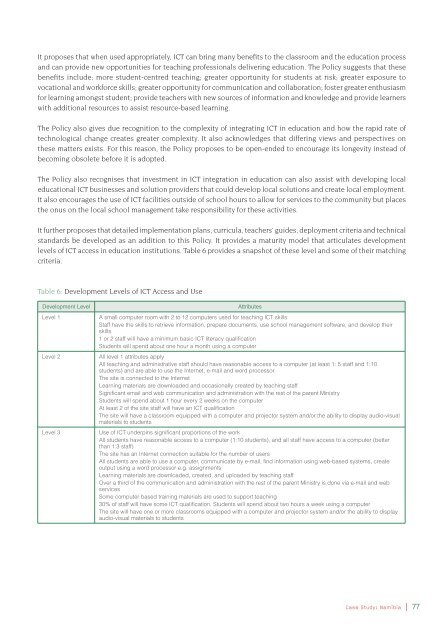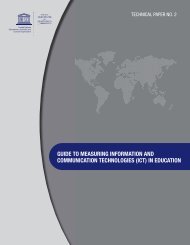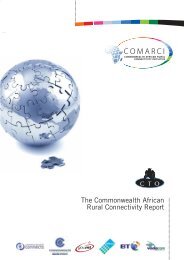Transforming education: the power of ICT policies - Commonwealth ...
Transforming education: the power of ICT policies - Commonwealth ...
Transforming education: the power of ICT policies - Commonwealth ...
Create successful ePaper yourself
Turn your PDF publications into a flip-book with our unique Google optimized e-Paper software.
It proposes that when used appropriately, <strong>ICT</strong> can bring many benefi ts to <strong>the</strong> classroom and <strong>the</strong> <strong>education</strong> process<br />
and can provide new opportunities for teaching pr<strong>of</strong>essionals delivering <strong>education</strong>. The Policy suggests that <strong>the</strong>se<br />
benefi ts include: more student-centred teaching; greater opportunity for students at risk; greater exposure to<br />
vocational and workforce skills; greater opportunity for communication and collaboration; foster greater enthusiasm<br />
for learning amongst student; provide teachers with new sources <strong>of</strong> information and knowledge and provide learners<br />
with additional resources to assist resource-based learning.<br />
The Policy also gives due recognition to <strong>the</strong> complexity <strong>of</strong> integrating <strong>ICT</strong> in <strong>education</strong> and how <strong>the</strong> rapid rate <strong>of</strong><br />
technological change creates greater complexity. It also acknowledges that differing views and perspectives on<br />
<strong>the</strong>se matters exists. For this reason, <strong>the</strong> Policy proposes to be open-ended to encourage its longevity instead <strong>of</strong><br />
becoming obsolete before it is adopted.<br />
The Policy also recognises that investment in <strong>ICT</strong> integration in <strong>education</strong> can also assist with developing local<br />
<strong>education</strong>al <strong>ICT</strong> businesses and solution providers that could develop local solutions and create local employment.<br />
It also encourages <strong>the</strong> use <strong>of</strong> <strong>ICT</strong> facilities outside <strong>of</strong> school hours to allow for services to <strong>the</strong> community but places<br />
<strong>the</strong> onus on <strong>the</strong> local school management take responsibility for <strong>the</strong>se activities.<br />
It fur<strong>the</strong>r proposes that detailed implementation plans, curricula, teachers’ guides, deployment criteria and technical<br />
standards be developed as an addition to this Policy. It provides a maturity model that articulates development<br />
levels <strong>of</strong> <strong>ICT</strong> access in <strong>education</strong> institutions. Table 6 provides a snapshot <strong>of</strong> <strong>the</strong>se level and some <strong>of</strong> <strong>the</strong>ir matching<br />
criteria.<br />
Table 6: Development Levels <strong>of</strong> <strong>ICT</strong> Access and Use<br />
Development Level Attributes<br />
Level 1 A small computer room with 2 to 12 computers used for teaching <strong>ICT</strong> skills<br />
Staff have <strong>the</strong> skills to retrieve information, prepare documents, use school management s<strong>of</strong>tware, and develop <strong>the</strong>ir<br />
skills<br />
1 or 2 staff will have a minimum basic <strong>ICT</strong> literacy qualifi cation<br />
Students will spend about one hour a month using a computer<br />
Level 2 All level 1 attributes apply<br />
All teaching and administrative staff should have reasonable access to a computer (at least 1: 5 staff and 1:10<br />
students) and are able to use <strong>the</strong> Internet, e-mail and word processor<br />
The site is connected to <strong>the</strong> Internet<br />
Learning materials are downloaded and occasionally created by teaching staff<br />
Signifi cant email and web communication and administration with <strong>the</strong> rest <strong>of</strong> <strong>the</strong> parent Ministry<br />
Students will spend about 1 hour every 2 weeks on <strong>the</strong> computer<br />
At least 2 <strong>of</strong> <strong>the</strong> site staff will have an <strong>ICT</strong> qualifi cation<br />
The site will have a classroom equipped with a computer and projector system and/or <strong>the</strong> ability to display audio-visual<br />
materials to students<br />
Level 3 Use <strong>of</strong> <strong>ICT</strong> underpins signifi cant proportions <strong>of</strong> <strong>the</strong> work<br />
All students have reasonable access to a computer (1:10 students), and all staff have access to a computer (better<br />
than 1:3 staff)<br />
The site has an Internet connection suitable for <strong>the</strong> number <strong>of</strong> users<br />
All students are able to use a computer, communicate by e-mail, fi nd information using web-based systems, create<br />
output using a word processor e.g. assignments<br />
Learning materials are downloaded, created, and uploaded by teaching staff<br />
Over a third <strong>of</strong> <strong>the</strong> communication and administration with <strong>the</strong> rest <strong>of</strong> <strong>the</strong> parent Ministry is done via e-mail and web<br />
services<br />
Some computer based training materials are used to support teaching<br />
30% <strong>of</strong> staff will have some <strong>ICT</strong> qualifi cation. Students will spend about two hours a week using a computer<br />
The site will have one or more classrooms equipped with a computer and projector system and/or <strong>the</strong> ability to display<br />
audio-visual materials to students<br />
Case Study: Namibia | 77
















